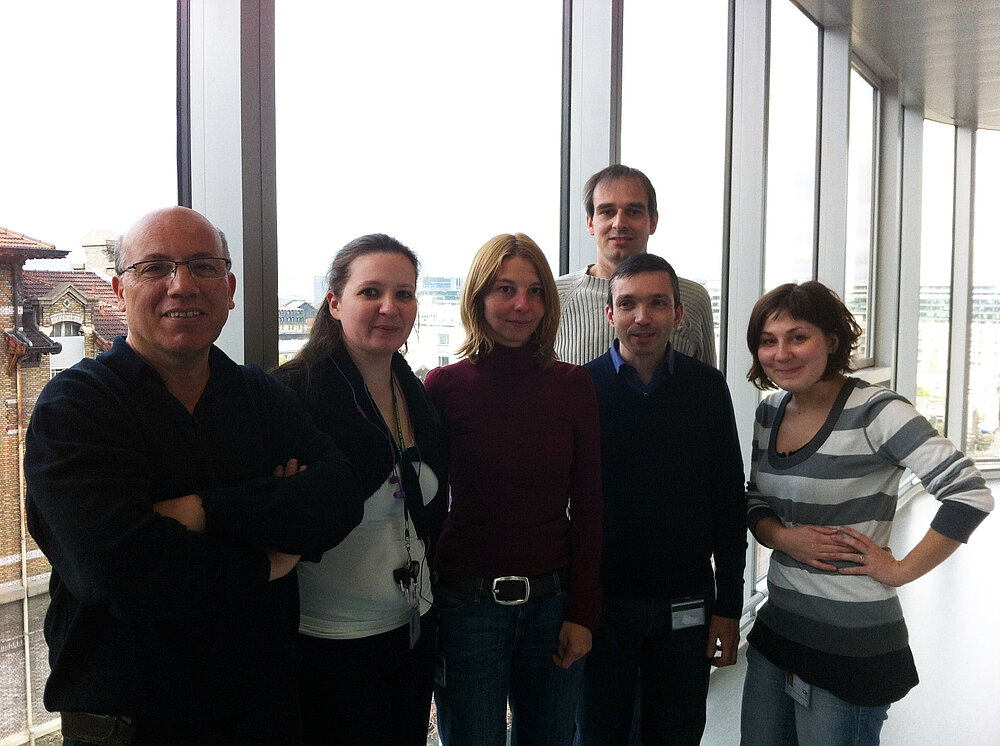Mouse models for SPG11 and SPG49 diseases.
Khalid H. El Hachimi PhD
Laboratoire de Neurogénétique EPHE
ICM UPMC, Inserm UMR_S1127/CNRS UMR 7225
Hôpital Pitié-Salpêtrière
Bâtiment de l'ICM - 4ème étage - Aile A
47 boulevard de l'Hôpital
75651 Paris Cedex 13
France
Tel : (33) 0157274650
Since 2011, with Giovanni Stevanin myself have created a group of neurogenetics at the Ecole Pratique des Hautes Etudes (post-graduated School) at the Institut du Cerveau et de la Moelle épinière (ICM). My research interest are on the genotype-phenotype correlations of hereditary spastic paraplegias (SPG). Our group, within the Alexis Brice’s team, contributed recently to identification of numerous genes responsible for these affections and brought a new data in the understanding of their physiopathology.I’m particulrly involved in celllular and animal models studies of these affections.
We recently developped two KO mouse models, respectively for SPG11 and SPG49 genes. The two genes were identified by our team (Stevanin et al., 2007 and Tesson et al., 2012).SPG11 encodes spatacsin, a protein which function is indeed largely unknown, but its interactions with AP51Z (SPG48) (Slabiki et al., 2010), a member of the Adaptor-protein-5 complex, suggests that its plays a role in intracellular trafficking (Hirst et al., 2013). With others members of our team (F. Farios, J Branchu) we are currently caracterizing behavioural and histopathological phenotype of the SPG11 mice.On other hand, SPG49 encodes a P450 cytochrome CYP2U1, considered as an orphan cytochrome. Its role remains largely unknown. The Cyp2u1 KO mice are now in our institute, the homozygous mouse are viable and fertile. We are starting with C. Pujol and F. Darios a phenotypic investigations of the brains and fibroblasts of these mice, together with a behavioral study in order to precise the pathological mechanism involved in this peculiar severe spastic paraplegia.
Final report
Title: Mouse models for SPG49/56 diseases.
(Final report)
Claire Pujol, Frédéric Darios, Giovanni Stevanin, Khalid H. EL Hachimi
Institut du Cerveau et de la Moelle épinière, Paris, France
During the last years, work done under the supervision of Prof. Giovanni Stevanin pinpointed the link between new mutations found in patients with hereditary spstic paraplegia and lipid metabolism (Tesson et al, Am J Hum Genet 2012; Boukhris et al, Am J Hum Genet 2013; Martin et al, Am J Hum Genet 2013). Among these genes, CYP2U1 was identified mutated in families with various geographical origins by the host group and then confirmed by others. Theses mutations are responsible for the autosomal recessive (AR) form of hereditary spastic paraplegia subtype 49/56 (according to the HUGO or NCBI nomenclature).
CYP2U1 is coding for one of the oldest identifiable vertebrate cytochrome P450 proteins implicated in ω and ω-1 fatty acid hydroxylation, with a dual localization in mitochondria and endoplasmic reticulum (ER) (Tesson et al, Am J Hum Genet 2012; and unpublished data). Previous work done in the laboratory demonstrated that lymphoblasts of mutated patients show mitochondrial dysfunction with alteration of ER and mitochondrial architecture in fibroblasts from one patient.
Generation of loss-of-function mouse model for CYP2U1
Given the nature of the mutations involved, we decided to model this human neurodegenerative disorder in mouse. An inducible knockout mouse model (KO) of SPG49 was generated in collaboration with the “Institut de la Clinique de la Souris” (Strasbourg, France). Heterozygous mice have been transferred in early 2015 at the host Institute following embryo transfer. We next generated homozygous Cyp2U1-/- mice using the Cre-loxP recombination system, with a Cre recombinase under the control of a human cytomegalovirus (CMV) promoter, active in most cells and tissues. Finally to obtain a pure genetic background, we backcrossed the offsprings with standard C57BL/6J strain.
Generation of appropriate cohort of our mouse model for CYP2U1
The resulting homozygous mice were viable and fertile. We then begin to amplify them in order to obtain enough mice for phenotypical and biochemical analyses using our expertise in another model generated in the host lab for SPG11 (Branchu et al, submitted).
Phenotypical analysis of Cyp2U1 deficient mice
We decided to look for the consequences of Cyp2U1 deficiency on the general behavioural phenotype and monitor any signs of motor and cognitive deficits in the Cyp2U1-/- animals. The locomotors activity and the coordination are determined by Rotarod tests, while cognitive alterations is tested with Y-Maze. These tests will be performed at various stages of the disease, according to the progression of the defects, at the Mouse Behavioral Phenotyping platform in the host Institute.
In February 2015 we obtained the first cohort for behaviour analysis. The preliminary results indicate that the Cyp2U1 deficient mice showed a cognitive alteration without a motor deficit at 2 month of age. The number of mice will be increased to confirm statistically this deficit. We have also planned to repeat these tests at 4/8/12 and 16 month of age to monitor the progression of the cognitive deficit, and to detect possible motor deficit, as in human, SPG49 phenotype was associated with a severe spastic paraplegia involving the lower and upper limbs.
General analysis of Cyp2U1 deficient mice
CYP2U1 is known to be expressed in different tissues (thymus, muscle and brain). An important point for our study is to identify the expression pattern in our mouse model, and especially the expression pattern in the central nervous system. To achieve this goal, we are using the expression of the bacterial beta-galactosidase reporter gene (lacZ) introduced in exon 1 of the gene and then driven by the endogenous Cyp2u1 promoter as a reporter in our KO mice. Indeed, the low specificity of our CYP2U1 antibody forced us to use this common reporter for the in vivo analysis of Cyp2u1 expression in transgenic mice.
First histochemical staining for LacZ enzyme activities were not successful to determine the gene expression patterns at 2 month of age, probably due to the low expression of the gene. We are currently collecting various tissue sections from earlier/latest stage to carry on this immunohistochemical studies.
We are also considering to generate a high quality polyclonal antibody against mouse CYP2U1.
In conclusion, the basic characterization of Cyp2U1 deficient mice to validate the KO model will be the first step before the characterization of the molecular mechanism impaired by the absence of Cyp2U1. We hope that this characterization will allow us to identify overlaps in lipid and mitochondrial impairment between mice and human samples. These results will provide us a frame of reference for molecules that can be targeted, either for biomarkers, as currently diagnosis relies on molecular screening of a plethora of genes; or for therapeutic agents since no specific treatment is at this time available, despite the progress in gene identification.
Funding provided by the Tom Wahlig foundation was used to generate the cohort of animals (backcross, housing of animals) currently analysed in behavioural tests and to pay the booking of the platform for these experiments.




